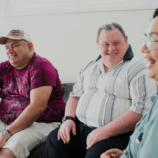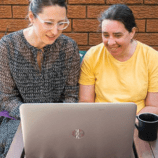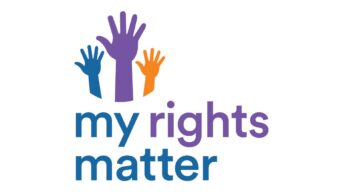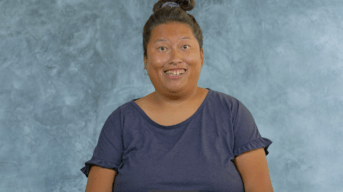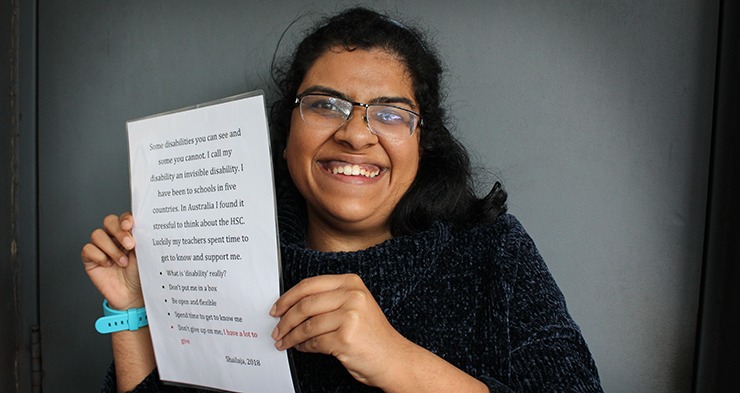
People with disability crafting an inclusive society
Our Project Worker Shailaja Menon reports on her trip to the Speak Out Conference, where she ran a fun workshop with a serious aim: to help people with intellectual disability share their stories and make communities more inclusive.
In September I attended the ‘Speak out Conference’ in Launceston, Tasmania. It was great to share ideas about inclusion with other people. I also enjoyed hearing speakers talk about how our community can include people with disability.
But the big highlight for me was running my own workshop with help from Linda Mitchell of Council for Intellectual Disability (CID), who was assisting me on the trip.
The workshop was so that people with disabilities can get the skills and the power to present their story in the community in a more creative and simpler way, rather than having to explain what their challenges are or the areas they need assistance in.
I used a skill that I learned from CID: creating an inclusion card.
The idea of an inclusion card is to have a little bit of a story about you – just a general outline of who you are – and share the experiences you have had and what sort of changes you want to see in the community.
Inclusion cards help people understand more about disability, so that our community can be more inclusive. I talk more about inclusion cards below.
To start the workshop, I showed participants a sample of an inclusion card that Linda and I had made, just to give them an idea of what we’re trying to achieve with it. And then we got them to make their own card with images and materials we provided.
I helped by looking over their shoulders and facilitating as they made their own card. And I was open to answer any questions if they were confused about something.
I think people really enjoyed the workshop – it was hard for me to know because I was so busy helping them make their cards! But judging by their body language it was clear they really did like it. I hope that they can use their card to share their stories.
I was so glad to have the chance to go to the Speak Out Conference. I found the conference a great learning experience. But the best bit was being able to help others through the workshop.
About inclusion cards
Very often when you go out in public or to an event, you don’t have a lot of time to explain your entire story or details about your disability.
An inclusion card is a very simple way to tell people about yourself without you having to explain your whole story again and again.
An inclusion card is a piece of paper or cardboard with pictures and writing on it. You can put on the card all sorts of things about you, what you like, what you don’t like, and the things that are important to you. The card helps people get a bit of an idea of you and also understand how they can support you.
An inclusion card looks good. It’s creative. It’s a bit of you. You kind of make a relationship with it.
It’s not just an item that someone gives you and says ‘this is a tool for you, use it.’ It’s your card. You have the freedom to make it your own.
If you would like to make your own inclusion card, follow the steps at the bottom of this blog. Get creative and have fun!

Make your own inclusion card
- You will need a piece of coloured paper or cardboard, a pen, some pictures cut from a magazine or printed from the internet, scissors, glue, and a sense of adventure!
- Think about your own personal story. What do you want other people to know about you? How do you like to be treated? How do you communicate? What is important to you?
- There’s lots of messages and words you can use to help people see you the way you want them to see you, and accept you for who you are. Think about how you want people to see you. For example, ‘I have a disability, but I’m just like you’, ‘Don’t judge me’, ‘Spend the time to get to know me’, and ‘Be open and flexible’.
- Find pictures that match your messages.
- Glue your pictures on your card, and write your messages beside them.
- On the back of the card, you can put more information about you.
- Once you have your card, take it wherever you go. Show it to people so they can get to know you, understand your needs and choose the right way to communicate with you. For example, take your card when you go out for a coffee to help the café staff understand how best to serve you.
- You can always change your card, or make a new one. You can have more than one card. Change your cards to use however you want. It’s up to you!
About Shailaja’s trip
The Speak Out Self Advocacy Conference was held 14-15 September 2018 in Launceston, Tasmania. Speak Out is the longest running conference for people with disability in Australia.
Shailaja presented her workshop as part of our Inclusion Point project, which is a partnership between CID and VALiD. Inclusion Point is funded through an NDIS Information, Linkages and Capacity Building (ILC) grant.
Find out more
- View our Inclusion High5 video that Shailaja helped to create.
- Watch Shailaja’s My Work Matters video about her work as a peer educator on respectful relationships for women with intellectual disability.
- Speak Out Conference website.



 1800 424 065
1800 424 065 








